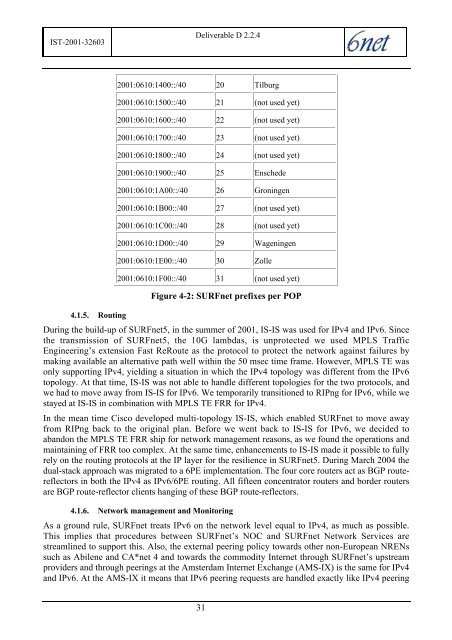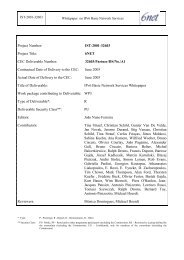D2.2.4: Final IPv4 to IPv6 Transition Cookbook for ... - 6NET
D2.2.4: Final IPv4 to IPv6 Transition Cookbook for ... - 6NET
D2.2.4: Final IPv4 to IPv6 Transition Cookbook for ... - 6NET
You also want an ePaper? Increase the reach of your titles
YUMPU automatically turns print PDFs into web optimized ePapers that Google loves.
IST-2001-32603Deliverable D 2.2.44.1.5. Routing2001:0610:1400::/40 20 Tilburg2001:0610:1500::/40 21 (not used yet)2001:0610:1600::/40 22 (not used yet)2001:0610:1700::/40 23 (not used yet)2001:0610:1800::/40 24 (not used yet)2001:0610:1900::/40 25 Enschede2001:0610:1A00::/40 26 Groningen2001:0610:1B00::/40 27 (not used yet)2001:0610:1C00::/40 28 (not used yet)2001:0610:1D00::/40 29 Wageningen2001:0610:1E00::/40 30 Zolle2001:0610:1F00::/40 31 (not used yet)Figure 4-2: SURFnet prefixes per POPDuring the build-up of SURFnet5, in the summer of 2001, IS-IS was used <strong>for</strong> <strong>IPv4</strong> and <strong>IPv6</strong>. Sincethe transmission of SURFnet5, the 10G lambdas, is unprotected we used MPLS TrafficEngineering’s extension Fast ReRoute as the pro<strong>to</strong>col <strong>to</strong> protect the network against failures bymaking available an alternative path well within the 50 msec time frame. However, MPLS TE wasonly supporting <strong>IPv4</strong>, yielding a situation in which the <strong>IPv4</strong> <strong>to</strong>pology was different from the <strong>IPv6</strong><strong>to</strong>pology. At that time, IS-IS was not able <strong>to</strong> handle different <strong>to</strong>pologies <strong>for</strong> the two pro<strong>to</strong>cols, andwe had <strong>to</strong> move away from IS-IS <strong>for</strong> <strong>IPv6</strong>. We temporarily transitioned <strong>to</strong> RIPng <strong>for</strong> <strong>IPv6</strong>, while westayed at IS-IS in combination with MPLS TE FRR <strong>for</strong> <strong>IPv4</strong>.In the mean time Cisco developed multi-<strong>to</strong>pology IS-IS, which enabled SURFnet <strong>to</strong> move awayfrom RIPng back <strong>to</strong> the original plan. Be<strong>for</strong>e we went back <strong>to</strong> IS-IS <strong>for</strong> <strong>IPv6</strong>, we decided <strong>to</strong>abandon the MPLS TE FRR ship <strong>for</strong> network management reasons, as we found the operations andmaintaining of FRR <strong>to</strong>o complex. At the same time, enhancements <strong>to</strong> IS-IS made it possible <strong>to</strong> fullyrely on the routing pro<strong>to</strong>cols at the IP layer <strong>for</strong> the resilience in SURFnet5. During March 2004 thedual-stack approach was migrated <strong>to</strong> a 6PE implementation. The four core routers act as BGP routereflec<strong>to</strong>rsin both the <strong>IPv4</strong> as <strong>IPv6</strong>/6PE routing. All fifteen concentra<strong>to</strong>r routers and border routersare BGP route-reflec<strong>to</strong>r clients hanging of these BGP route-reflec<strong>to</strong>rs.4.1.6. Network management and Moni<strong>to</strong>ringAs a ground rule, SURFnet treats <strong>IPv6</strong> on the network level equal <strong>to</strong> <strong>IPv4</strong>, as much as possible.This implies that procedures between SURFnet’s NOC and SURFnet Network Services arestreamlined <strong>to</strong> support this. Also, the external peering policy <strong>to</strong>wards other non-European NRENssuch as Abilene and CA*net 4 and <strong>to</strong>wards the commodity Internet through SURFnet’s upstreamproviders and through peerings at the Amsterdam Internet Exchange (AMS-IX) is the same <strong>for</strong> <strong>IPv4</strong>and <strong>IPv6</strong>. At the AMS-IX it means that <strong>IPv6</strong> peering requests are handled exactly like <strong>IPv4</strong> peering31






